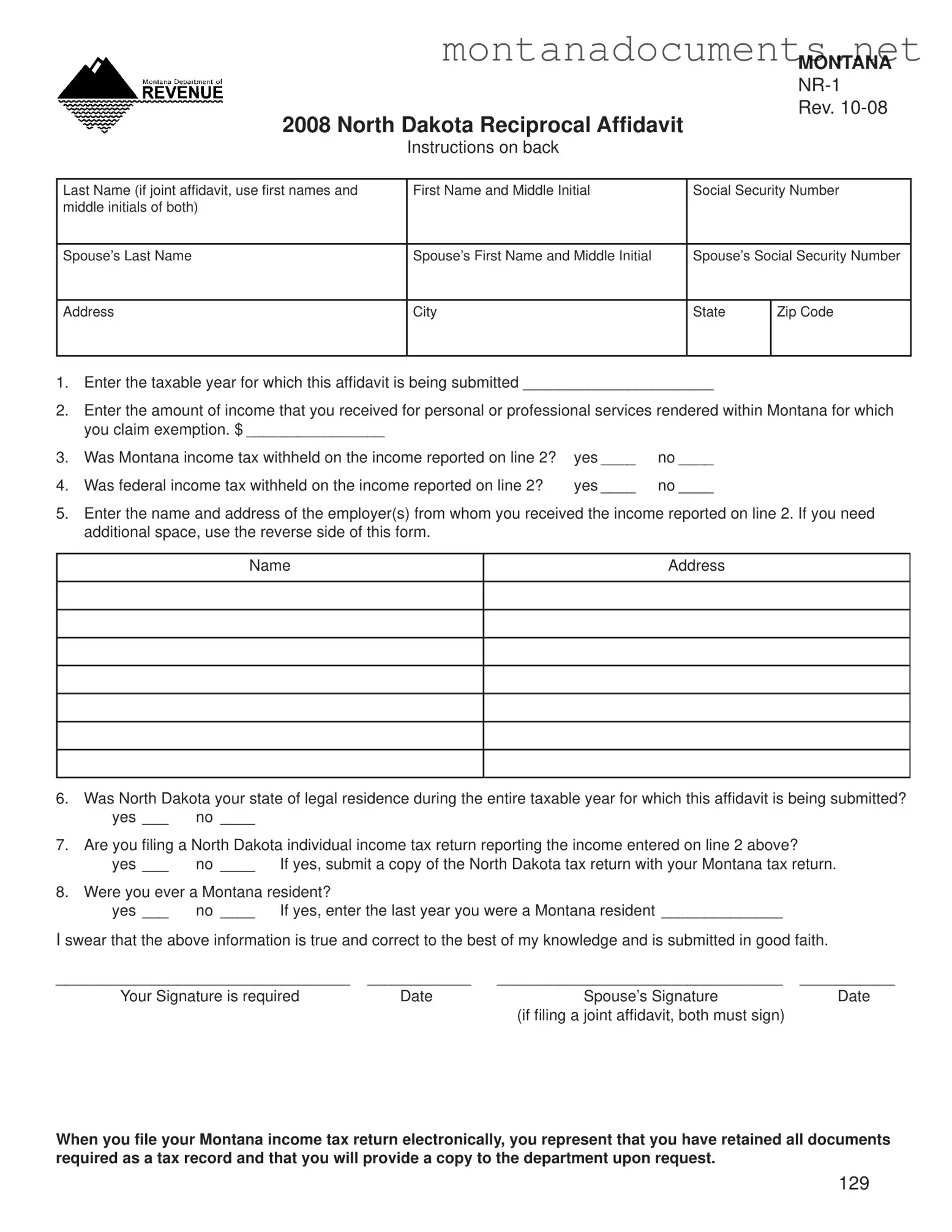The Montana NR-1 form is similar to the W-2 form, which is used to report wages paid to employees and the taxes withheld from those wages. Both forms require personal information such as names and Social Security numbers. However, while the W-2 focuses on reporting income and tax withholdings for a specific year, the NR-1 serves as an affidavit to claim exemption from Montana taxes for North Dakota residents. Essentially, the W-2 documents income earned, while the NR-1 asserts that certain income should not be taxed in Montana due to reciprocal agreements.
Another document akin to the Montana NR-1 is the 1099 form. This form is used to report various types of income other than wages, salaries, and tips. Like the NR-1, the 1099 requires detailed income information. However, the 1099 does not specifically address tax exemptions between states. Instead, it provides a summary of income that may require further tax reporting. Both forms emphasize the importance of accurately reporting income to the appropriate tax authorities.
The North Dakota Individual Income Tax Return (Form ND-1) is also similar to the NR-1. Taxpayers use this form to report their income to the state of North Dakota. While the NR-1 is focused on claiming an exemption for income earned in Montana, the ND-1 is the primary vehicle for reporting income and calculating taxes owed to North Dakota. Submitting both forms together ensures compliance with the tax laws of both states.
Additionally, the Montana Individual Income Tax Return (Form 2) bears similarities to the NR-1. This form is used by residents to report their income and calculate their tax liability in Montana. If Montana income tax has been withheld, residents must file Form 2 along with the NR-1 to claim their exemption. Both forms work together to clarify the tax obligations of individuals who earn income in Montana while being residents of North Dakota.
The Employee’s Certificate of North Dakota Residence (Form NR-2) also shares a connection with the NR-1. This form is used by employees to certify their residency in North Dakota to their employers, thereby preventing the withholding of Montana income tax. While the NR-1 is filed with the tax return, the NR-2 is presented to employers to ensure that tax withholdings are appropriately managed from the outset.
The IRS Form 1040 is another document that resembles the NR-1 in that it is a comprehensive tax return form used by individuals to report their income to the federal government. Both forms require personal information and details about income. However, the 1040 focuses on federal tax obligations, while the NR-1 specifically addresses state tax exemptions due to reciprocal agreements. Filing both forms ensures compliance with both federal and state tax laws.
The Schedule C form, used for reporting income or loss from a business operated as a sole proprietorship, is also similar to the NR-1. Both forms require detailed income reporting, but the Schedule C focuses on business income and expenses, while the NR-1 is concerned with personal income exemptions for tax purposes. Understanding both forms is crucial for individuals who may have both employment income and business income.
The 1098 form, which reports mortgage interest paid, shares a similarity with the NR-1 in that both require personal financial information. While the 1098 is used to report interest payments for tax deductions, the NR-1 is used to claim exemptions for income earned in Montana. Both forms play important roles in tax reporting and can affect overall tax liabilities.
When dealing with the sale of a dirt bike, it is advisable to utilize a thorough dirt bike bill of sale for California transactions. This document not only formalizes the sale but also protects both the buyer and seller by clearly outlining the details of the transaction.
The Form 8889, which is used for Health Savings Accounts (HSAs), is also somewhat comparable to the NR-1. Both forms require personal details and financial information. However, while the Form 8889 deals with health-related financial accounts, the NR-1 focuses on income tax exemptions between states. Understanding both forms is important for managing finances and tax obligations effectively.
Lastly, the Form 4868, which is an application for an automatic extension of time to file a federal tax return, can be seen as similar to the NR-1 in that it addresses tax obligations. Both forms require personal information and are crucial for ensuring compliance with tax deadlines. However, the Form 4868 is about extending the time to file, while the NR-1 is about claiming an exemption for taxes owed on specific income earned in Montana.
